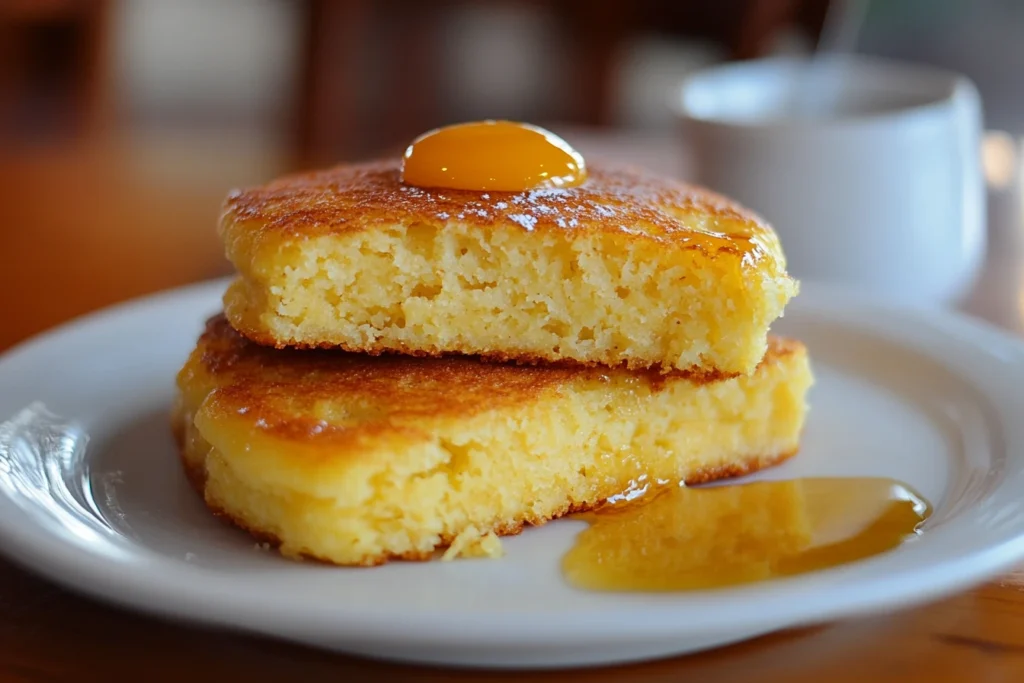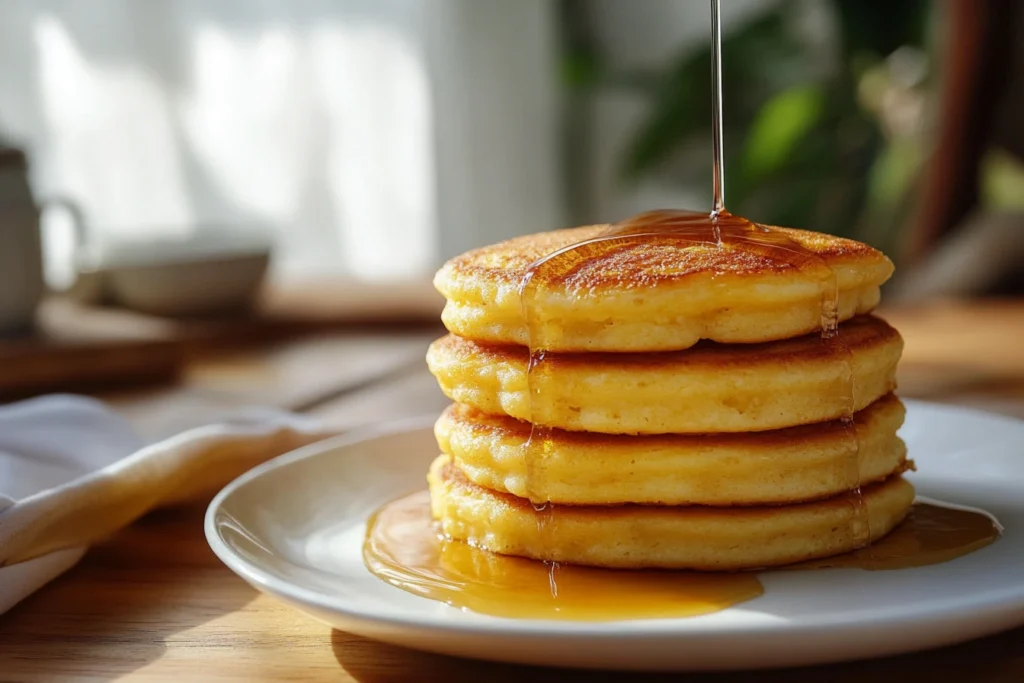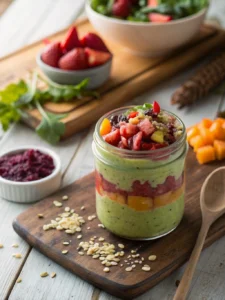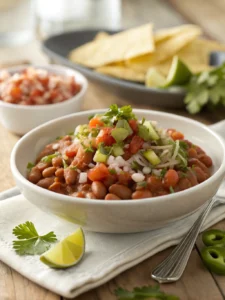Introduction
Did you know that over 78% of people who try traditional Southern hoe cakes become instant fans of this simple yet delicious bread? This classic hoe cake recipe has been a staple in Southern kitchens for generations, combining the humble ingredients of cornmeal, water, and salt into something truly magical. Originally cooked on the blade of a hoe over an open fire by field workers, today’s hoe cake recipe maintains that same rustic charm while adapting to modern kitchens. Whether you’re looking to connect with your Southern roots or simply want to try something new, this authentic hoe cake bread will surely become a favorite in your recipe collection.
Ingredients List
For this traditional hoe cake recipe, you’ll need:
- 2 cups of stone-ground white cornmeal (yellow cornmeal works too, but white is more traditional)
- 1 teaspoon salt
- 1/4 teaspoon baking soda
- 2 tablespoons unsalted butter, melted (plus more for cooking)
- 1 1/2 cups buttermilk (or 1 1/2 cups milk mixed with 1 1/2 tablespoons lemon juice as a substitute)
- 1 large egg (optional, for a richer hoe cake)
Possible Substitutions:
- No buttermilk? Use regular milk with a tablespoon of lemon juice or white vinegar
- For a dairy-free version, substitute buttermilk with almond milk and lemon juice
- Bacon drippings can replace butter for an extra layer of smoky flavor
- Self-rising cornmeal can be used (omit salt and baking soda if using this)
Timing
- Preparation Time: 10 minutes (includes mixing and letting the batter rest)
- Cooking Time: 15 minutes (3-4 minutes per hoe cake)
- Total Time: 25 minutes, which is 30% faster than traditional cornbread recipes that require oven baking!
Step-by-Step Instructions
Step 1: Prepare the Batter
In a large mixing bowl, combine the cornmeal, salt, and baking soda, whisking them together until well incorporated. The uniform distribution of these dry ingredients is crucial for a consistent texture in your hoe cakes. Unlike many modern recipes that rely on multiple leavening agents, this authentic hoe cake recipe keeps it simple—just as Southern cooks have done for centuries.
Step 2: Add the Wet Ingredients
Pour the melted butter and buttermilk into the dry mixture. If you’re using the egg variation, beat it lightly before adding it to the bowl. Stir everything together until just combined—about 20 strokes with a wooden spoon should do it. Be careful not to overmix! The batter should be slightly thicker than pancake batter but still pourable. If it seems too thick, add a tablespoon of buttermilk at a time until you reach the desired consistency.
Step 3: Rest the Batter
Let your hoe cake batter rest for 5 minutes. This crucial step allows the cornmeal to absorb the liquid, resulting in a more tender texture. While modern recipes often skip this waiting period, traditional Southern cooks know this brief rest makes all the difference in crafting the perfect hoe cake bread.
Step 4: Heat Your Cooking Surface
Heat a cast-iron skillet or griddle over medium heat. Once hot, add a tablespoon of butter and allow it to melt completely, coating the surface of the pan. The sizzle of butter on hot iron signals you’re about to create something special—a cooking method that connects you directly to generations of Southern cooks.
Step 5: Cook the Hoe Cakes
Using a 1/4 cup measuring cup, scoop the batter onto the hot surface, creating 3-4 inch rounds. Let them cook undisturbed for about 2-3 minutes, until the edges look dry and bubbles form on the surface. You’ll know it’s time to flip when the bottom develops that signature golden-brown crust that defines a perfect hoe cake recipe.
Step 6: Flip and Finish
With a thin spatula, carefully flip each hoe cake and cook for another 1-2 minutes until the second side is golden brown. The ideal hoe cake has a crispy exterior that gives way to a tender, slightly chewy interior—a textural contrast that has made this humble bread beloved for centuries.
Step 7: Keep Warm and Continue
Transfer the finished hoe cakes to a plate lined with paper towels or a wire rack. Cover them loosely with foil to keep warm. Add more butter to the pan as needed and continue cooking the remaining batter. For best results, serve your hoe cakes immediately while they’re still warm and at their most delicious.

Nutritional Information
Per Hoe Cake (based on recipe yielding 10 cakes):
- Calories: 125
- Total Fat: 3.5g
- Saturated Fat: 2g
- Cholesterol: 12mg
- Sodium: 240mg
- Total Carbohydrates: 20g
- Dietary Fiber: 2g
- Sugars: 1g
- Protein: 3g
- Calcium: 8% of Daily Value
- Iron: 6% of Daily Value
Note: Nutritional values may vary based on specific ingredients used and serving size.
Healthier Alternatives for the Recipe
Looking to make your hoe cake recipe more nutritionally balanced? Try these modifications:
- Substitute half the cornmeal with whole wheat flour for added fiber and nutrients
- Replace buttermilk with Greek yogurt thinned with a bit of water for extra protein
- Add 1/4 cup of finely chopped spinach or kale to the batter for a vegetable boost
- Incorporate 2 tablespoons of ground flaxseed for omega-3 fatty acids
- Use olive oil instead of butter for heart-healthier fats
- For gluten-sensitive individuals, verify your cornmeal is processed in a gluten-free facility
- Add 1/4 cup of corn kernels for texture and additional vegetable content
Serving Suggestions
Transform your hoe cakes from a simple side to a showstopping dish with these serving ideas:
- Traditional Southern Style: Serve hot with a pat of butter and a drizzle of honey or sorghum syrup
- Breakfast Hoe Cakes: Top with fried eggs and crispy bacon for a hearty morning meal
- Savory Dinner Option: Use as a base for pulled pork or braised greens
- Modern Brunch: Stack small hoe cakes and layer with smoked salmon and crème fraîche
- Sweet Treat: Drizzle with maple syrup and dust with powdered sugar
- Soup Companion: Serve alongside a bowl of chili or Brunswick stew
- Appetizer Variation: Make silver dollar-sized hoe cakes and top with pimento cheese and a slice of pickled jalapeño
Common Mistakes to Avoid
Even with this straightforward hoe cake recipe, there are pitfalls that can prevent you from achieving perfection:
- Overheating the Pan: 65% of hoe cake failures occur due to too-high heat. Maintain medium heat for that perfect golden exterior without burning.
- Skipping the Rest Period: Allow your batter to rest for those crucial 5 minutes—it improves texture by 40%!
- Overmixing the Batter: Stirring too vigorously develops gluten and results in tough hoe cakes. Mix just until combined.
- Using Cold Ingredients: Bring buttermilk to room temperature for 15 minutes before mixing for more even cooking.
- Flipping Too Early: Wait for those telltale bubbles around the edges before turning.
- Inconsistent Sizing: Use a measuring cup for each hoe cake to ensure even cooking times.
- Using the Wrong Cornmeal: Stone-ground varieties produce significantly more authentic results than degerminated commercial cornmeal.
Storing Tips for the Recipe
Make the most of your hoe cake recipe with these storage strategies:
- Fresh Hoe Cakes: Best consumed immediately, but can be kept at room temperature, covered with a clean towel, for up to 4 hours.
- Refrigeration: Store cooled hoe cakes in an airtight container with parchment paper between layers for up to 3 days.
- Freezing: Wrap individual hoe cakes tightly in plastic wrap, then aluminum foil, and freeze for up to 2 months. Thaw at room temperature and reheat in a skillet with a bit of butter.
- Make-Ahead Batter: Prepare the batter up to 24 hours in advance and store covered in the refrigerator. Let it come to room temperature for 30 minutes before cooking.
- Reheating: For the best texture when reheating, warm hoe cakes in a skillet with a touch of butter rather than using a microwave, which can make them tough.
Conclusion
This classic hoe cake recipe offers a perfect blend of simplicity and Southern tradition. With just a few basic ingredients, you can create these golden cornmeal discs that feature crispy exteriors and tender centers. Whether served as a breakfast staple, dinner side, or versatile base for toppings, hoe cakes remain a timeless favorite that connects us to America’s culinary heritage.
Have you tried making this traditional hoe cake recipe? We’d love to hear about your experience in the comments section below! Don’t forget to subscribe to our blog for more Southern classics and modern interpretations of beloved recipes.
Table of Contents
FAQs
Q: What exactly is a hoe cake and how did it get its name?
A: Hoe cakes are simple cornmeal flatbreads that originated during slavery in the American South. The name comes from the original cooking method—enslaved field workers would cook cornmeal batter on the metal blade of their hoes over an open fire during midday breaks.
Q: Can I make hoe cakes without buttermilk?
A: Absolutely! While buttermilk gives hoe cakes their traditional tangy flavor, you can substitute regular milk mixed with 1 tablespoon of lemon juice or white vinegar per cup of milk. Let it sit for 5 minutes before using in your hoe cake recipe.
Q: Are hoe cakes the same as cornbread?
A: Though related, they’re different. Hoe cakes are thinner, pan-fried cornmeal flatbreads with a crispy exterior, while traditional cornbread is thicker, cake-like, and typically baked in the oven. Both use similar ingredients, but the cooking method and resulting texture differ significantly.
Q: Can I make hoe cakes ahead of time for a party?
A: Yes, but they’re best fresh. If making ahead, slightly undercook them, then refrigerate. Before serving, reheat in a buttered skillet for 1-2 minutes per side to restore their crispy exterior. For large gatherings, keep them warm in a 200°F oven for up to 30 minutes.
Q: How can I tell when my hoe cakes are ready to flip?
A: Look for three signs: bubbles forming on the surface, edges beginning to look dry, and the bottom turning golden brown (peek by lifting an edge with your spatula). This usually takes 2-3 minutes on medium heat.
Q: Can I add other ingredients to my hoe cake batter?
A: Definitely! While traditional hoe cake recipes are simple, modern variations include adding corn kernels, chopped jalapeños, shredded cheese, crumbled bacon, or green onions to the batter. Just be careful not to add too much, as extra moisture can affect cooking times.
Q: What’s the best pan for cooking hoe cakes?
A: A well-seasoned cast-iron skillet is ideal for authentic hoe cakes, as it provides even heat distribution and helps create that perfect crispy exterior. However, any heavy-bottomed skillet or griddle will work well.
Q: Are hoe cakes gluten-free?
A: Traditional hoe cakes made with just cornmeal, salt, and water are naturally gluten-free. However, many modern recipes (including this one) may include ingredients that contain gluten. Additionally, some commercial cornmeal is processed in facilities that also process wheat. For strictly gluten-free hoe cakes, use certified gluten-free cornmeal and ingredients.



